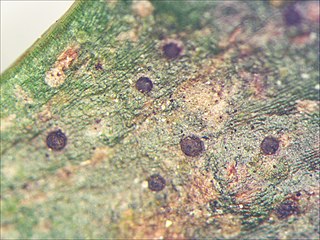
Pyrausta nigrata is a species of moth of the family Crambidae. It was described by Giovanni Antonio Scopoli in his 1763 Entomologia Carniolica and it is found in Europe.
Odozana is a genus of moths in the subfamily Arctiinae.

Tapellaria is a genus of leaf-dwelling lichens in the family Pilocarpaceae. The genus was circumscribed by lichenologist Johannes Müller Argoviensis in 1890, with Tapellaria herpetospora assigned as the type species.
Scotura is a genus of moths of the family Notodontidae. It consists of the following species:

Entomologia Carniolica exhibens insecta Carnioliae indigena et distributa in ordines, genera, species, varietates is a taxonomic work by Giovanni Antonio Scopoli, published in Vienna in 1763. As well as describing hundreds of new species, Entomologia Carniolica contained observations on the species' biology, including the first published account of queen bees mating outside the hive.
Stigmella nigrata is a moth of the family Nepticulidae. It was described by Edward Meyrick in 1913. It is found in South Africa.

The black mongoose is a subspecies of the Angolan slender mongoose occurring in Namibia and Angola. Although originally described as a separate species by Oldfield Thomas in 1928, it has often been considered a subspecies of the slender mongoose. However, genetic analysis indicated that it was distinct, and it was later classified as a distinct species. However, more evidence indicates that it is in fact conspecific with the Angolan slender mongoose.
Odozana cocciniceps is a moth of the subfamily Arctiinae. It was described by E. Dukinfield Jones in 1908. It is found in Panama.
Odozana decepta is a moth of the subfamily Arctiinae. It was described by Schaus in 1911. It is found in Costa Rica.
Odozana domina is a moth of the subfamily Arctiinae. It was described by Schaus in 1896. It is found in São Paulo, Brazil.
Odozana floccosa is a moth of the subfamily Arctiinae. It was described by Francis Walker in 1864. It is found in Panama and Tefé, Brazil.
Odozana incarnata is a moth of the subfamily Arctiinae. It was described by Peter Jörgensen in 1935 and it is found in Paraguay.
Odozana inconspicua is a moth of the subfamily Arctiinae. It was described by Schaus in 1911 and can be found in Costa Rica.
Odozana margina is a moth of the subfamily Arctiinae. It was described by Schaus in 1896. It is found in the Brazilian state of Paraná, Peru and Bolivia.
Odozana methaemata is a moth of the subfamily Arctiinae. It was described by George Hampson in 1900. It is found in Panama.
Odozana obscura is a moth of the subfamily Arctiinae. It was described by Schaus in 1896. It is found in Rio de Janeiro, Brazil.
Odozana patagiata is a moth of the subfamily Arctiinae. It was described by Paul Dognin in 1909. It is found in Bolivia.
Odozana roseiceps is a moth of the subfamily Arctiinae. It was described by Rothschild in 1913. It is found in Peru.
Odozana sixola is a moth of the subfamily Arctiinae. It was described by Schaus in 1911. It is found in Costa Rica and Panama.
Odozana unica is a moth of the subfamily Arctiinae. It was described by Schaus in 1905. It is found in Mexico.



